Charles E W Bean, Diaries, AWM38 3DRL 606/247/1 - 1917 - 1933 - Part 4
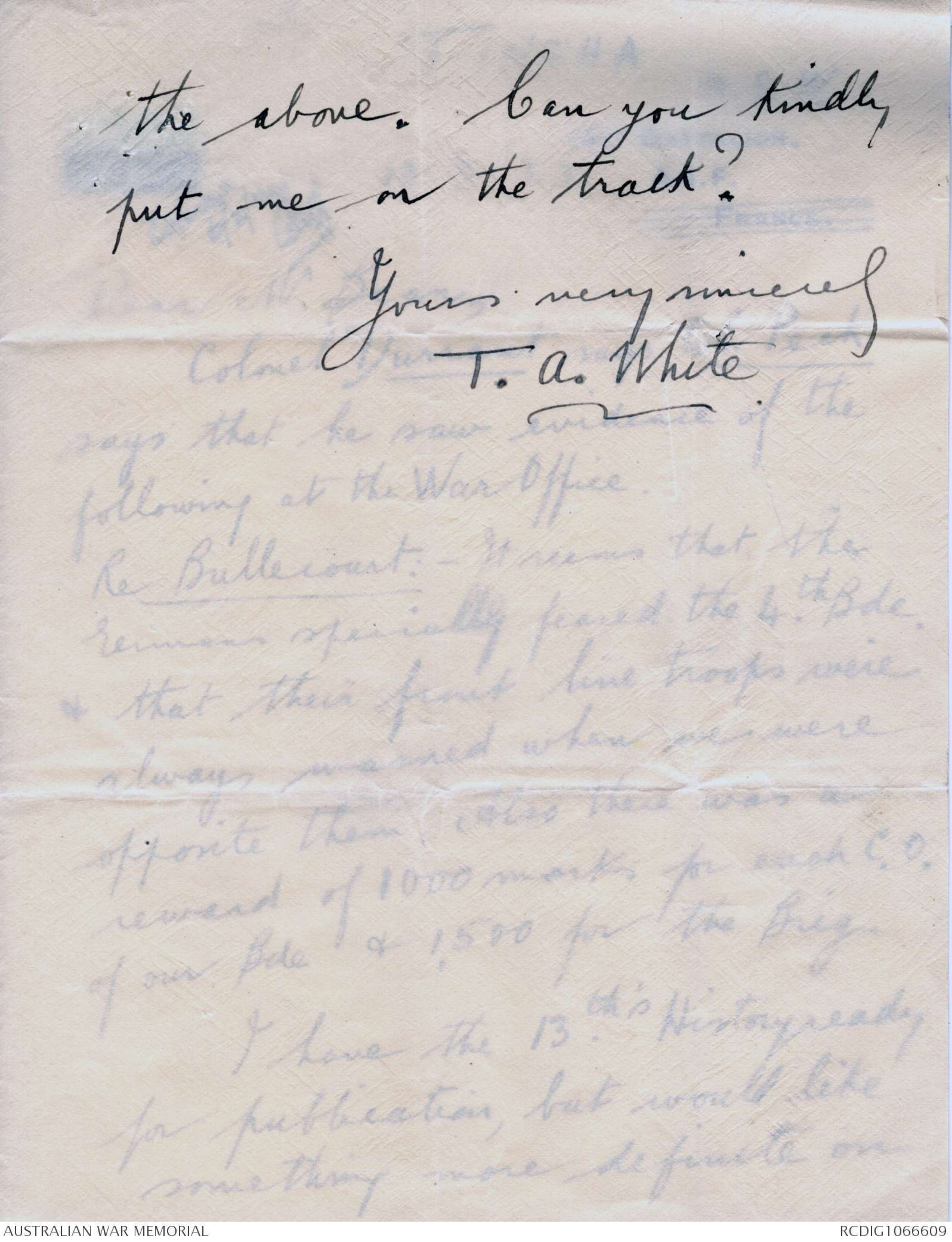
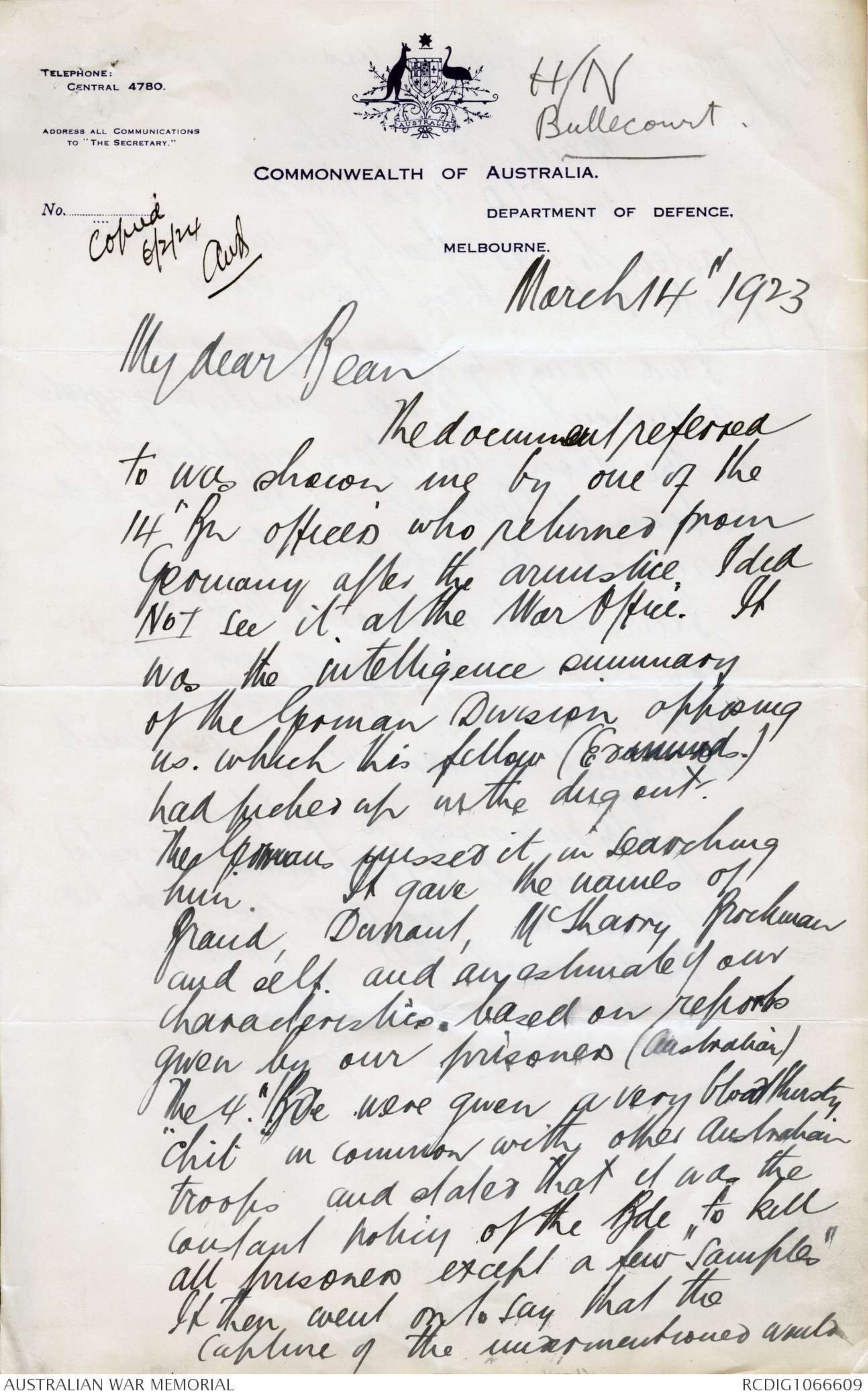
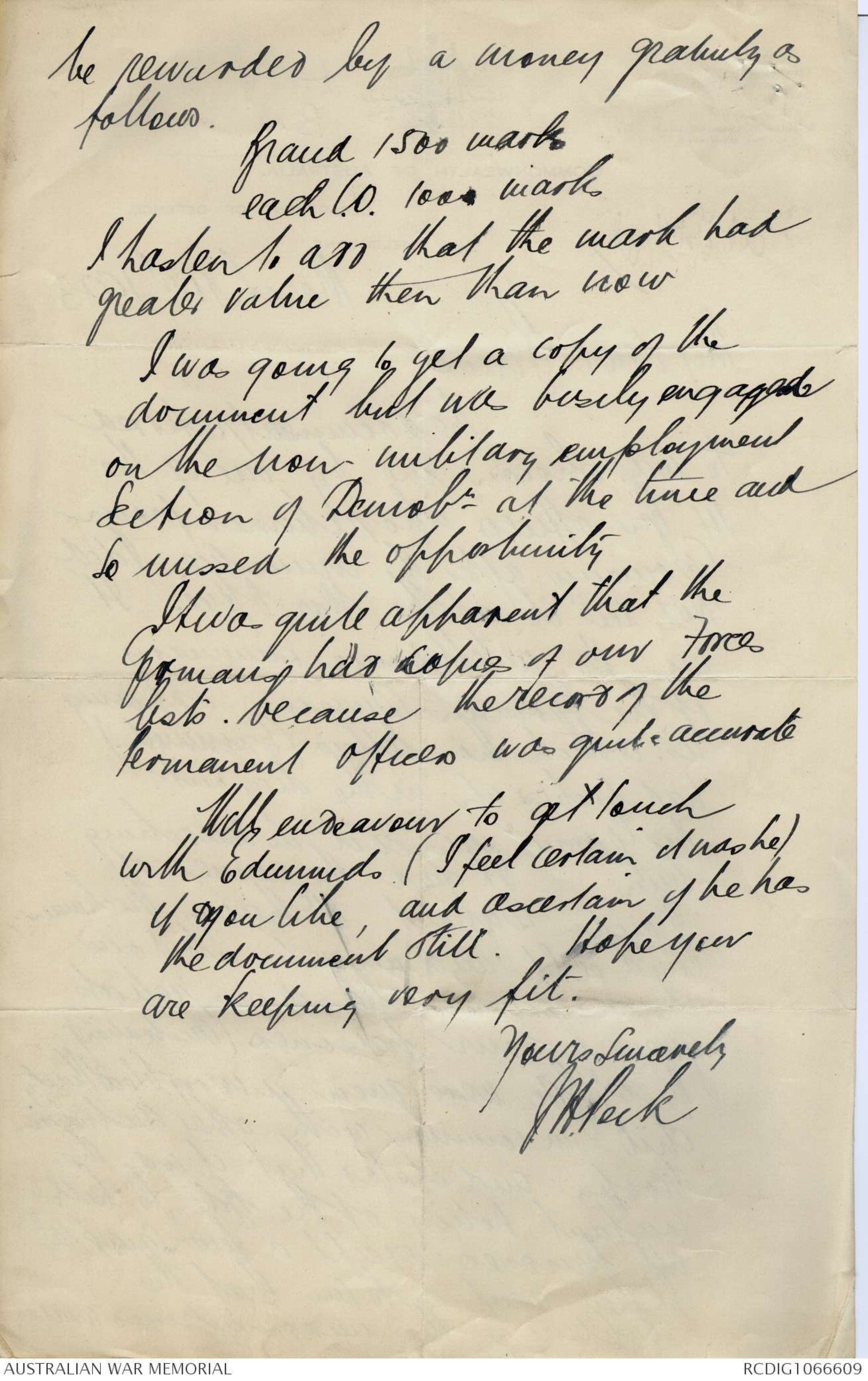
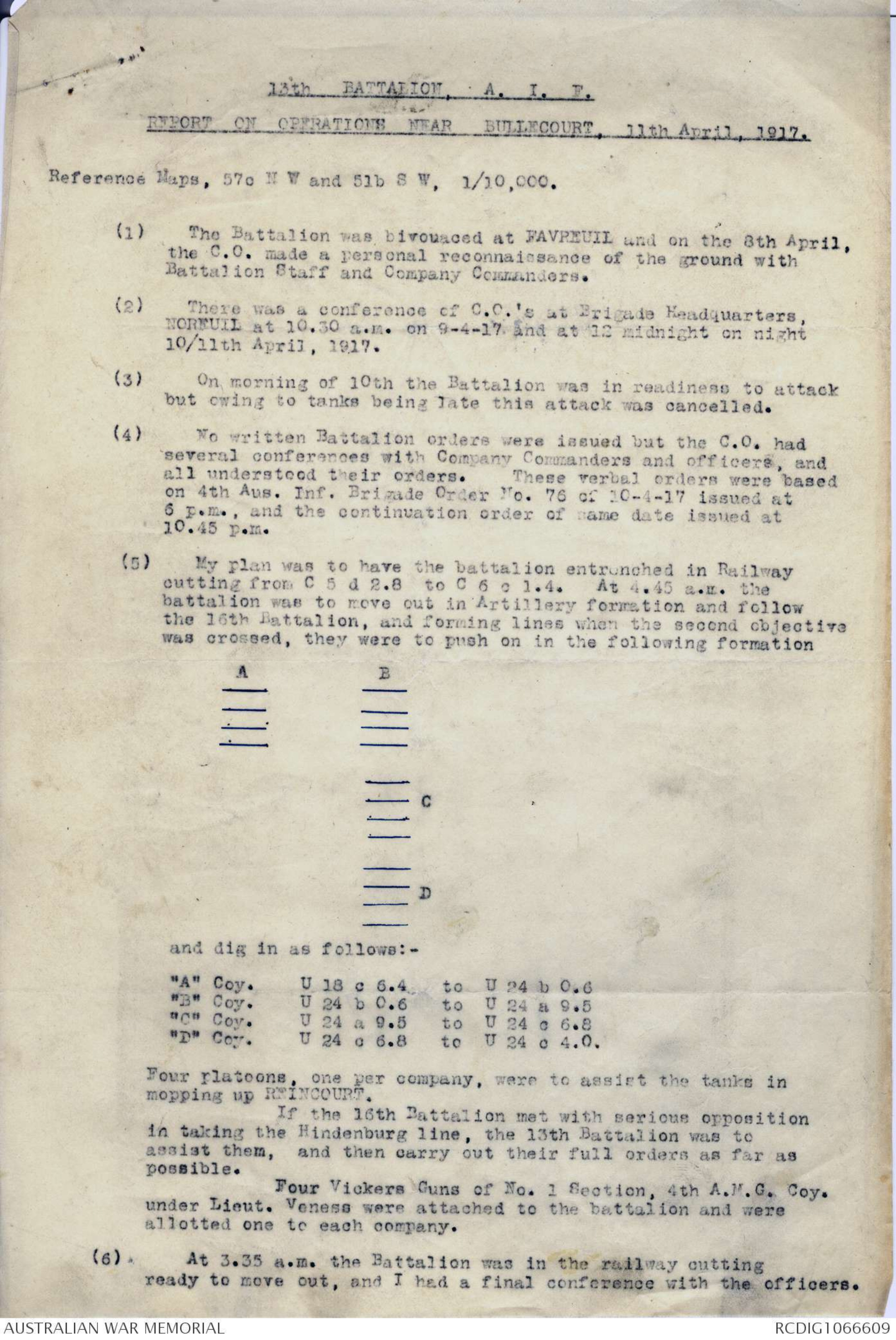
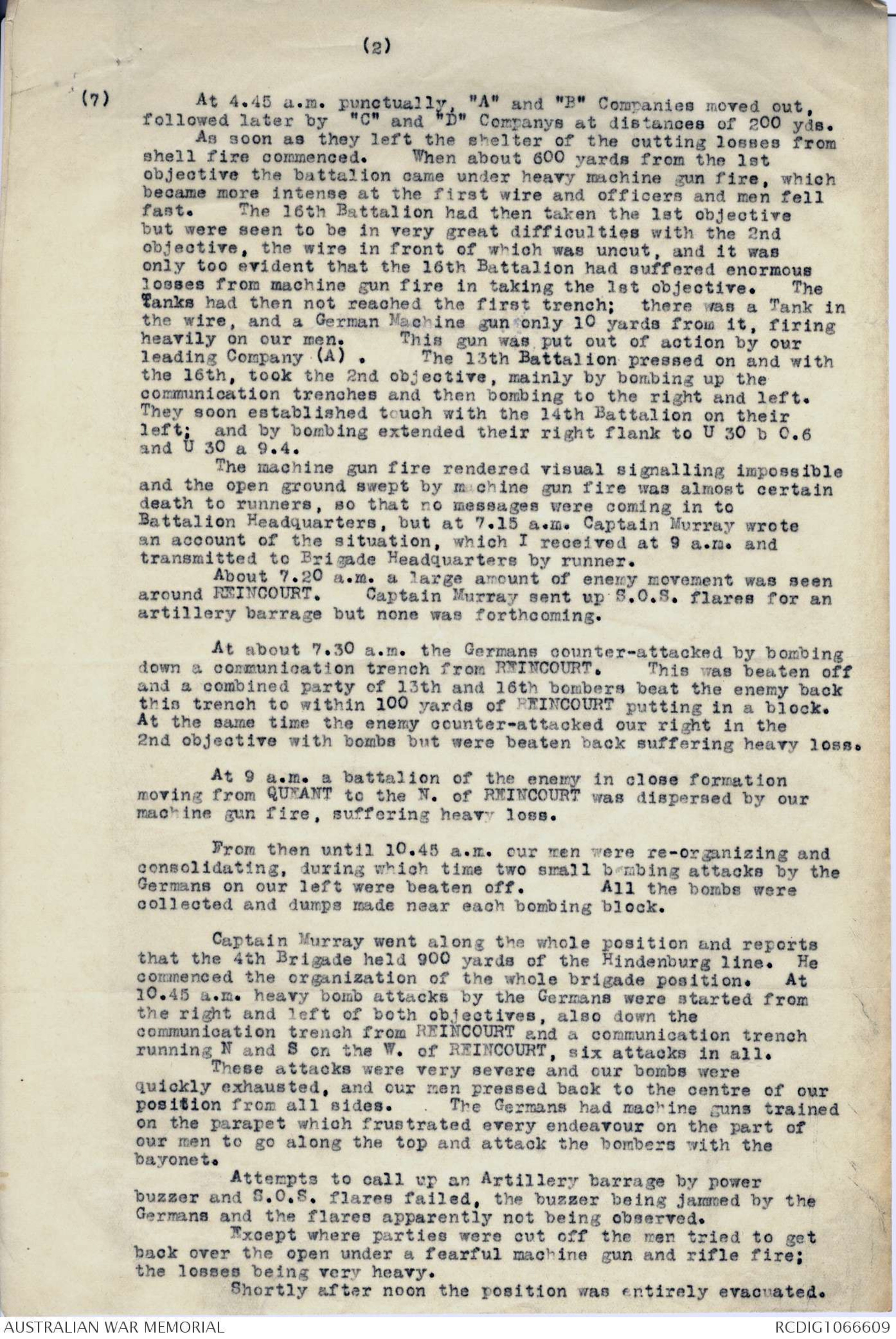
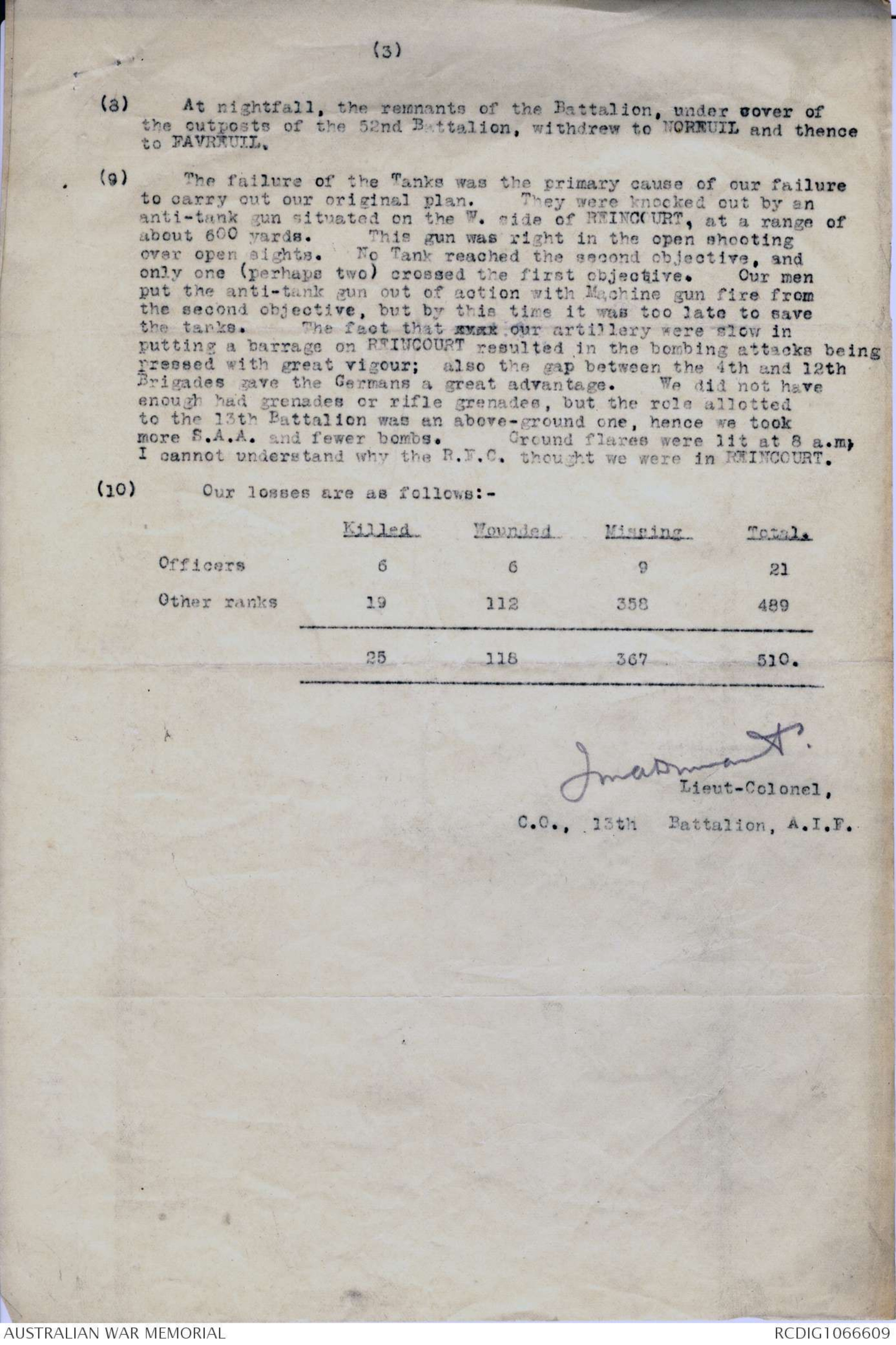
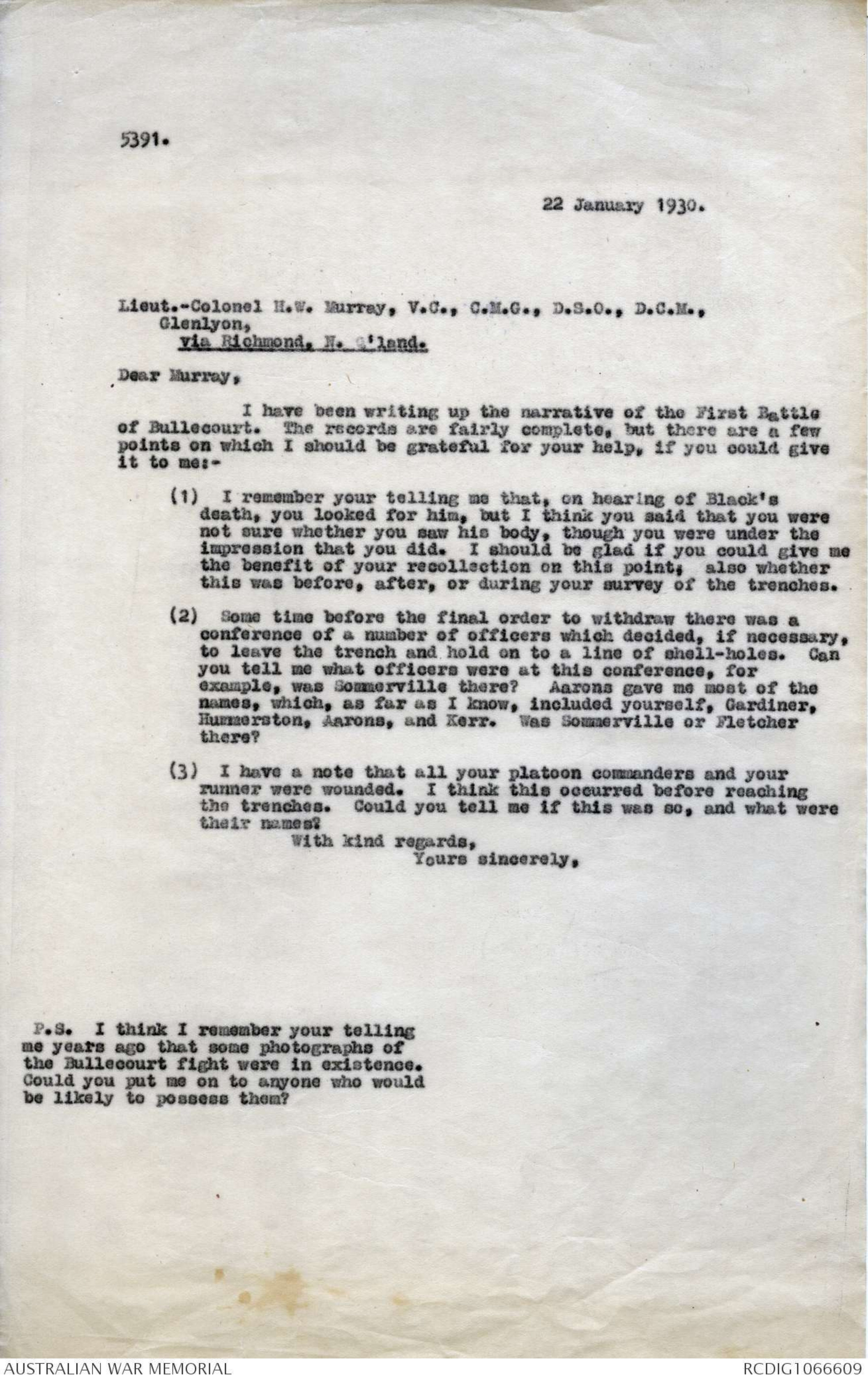
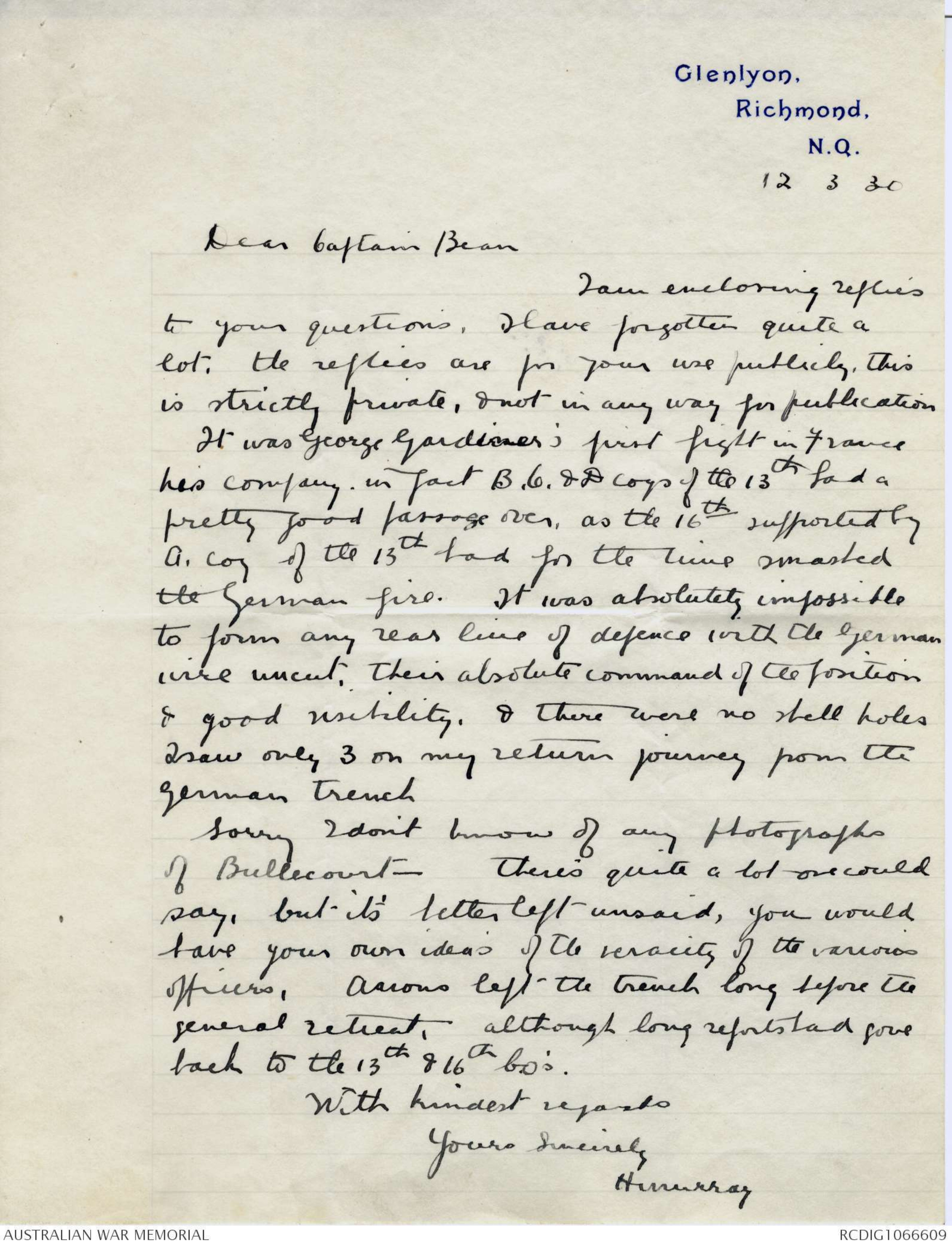
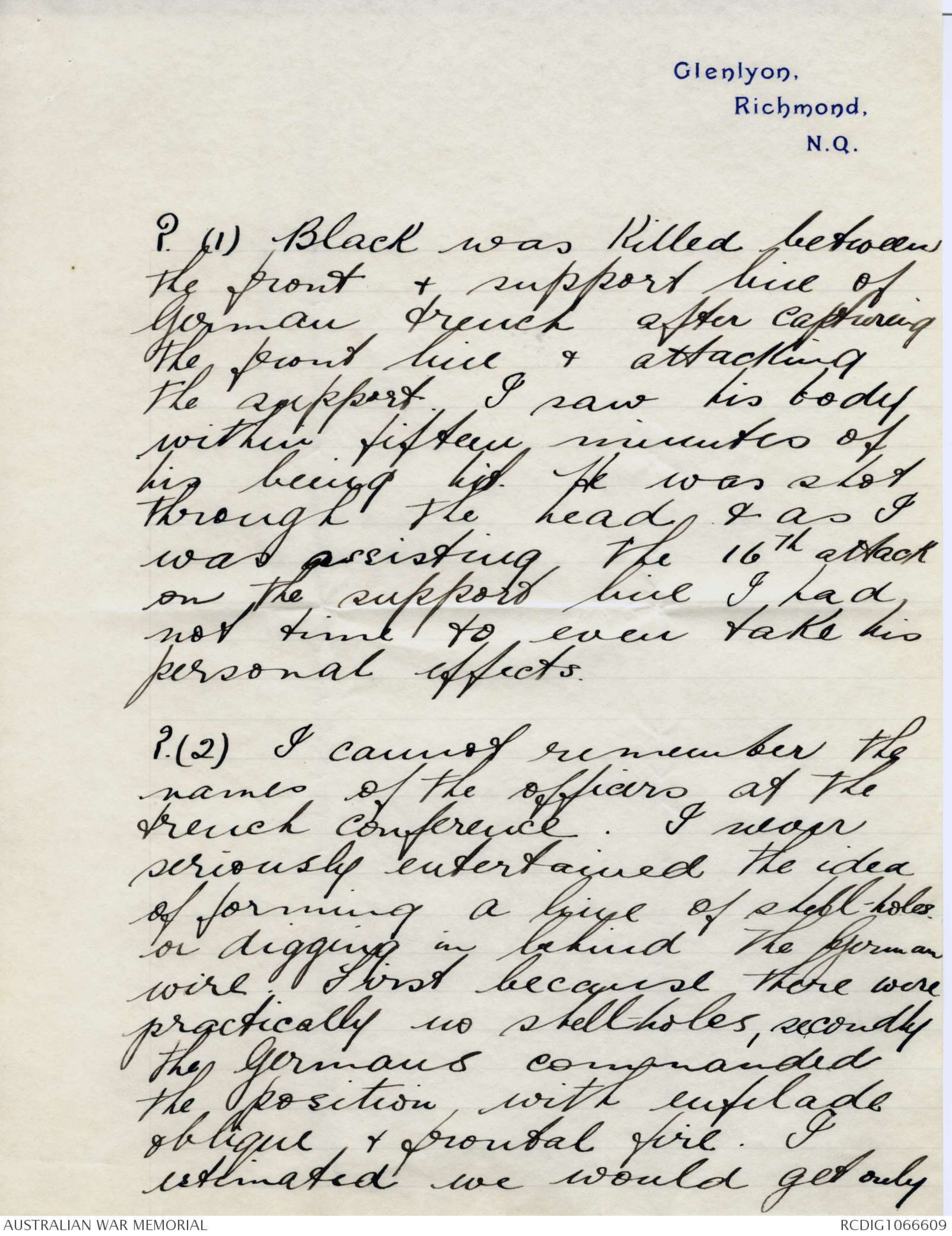
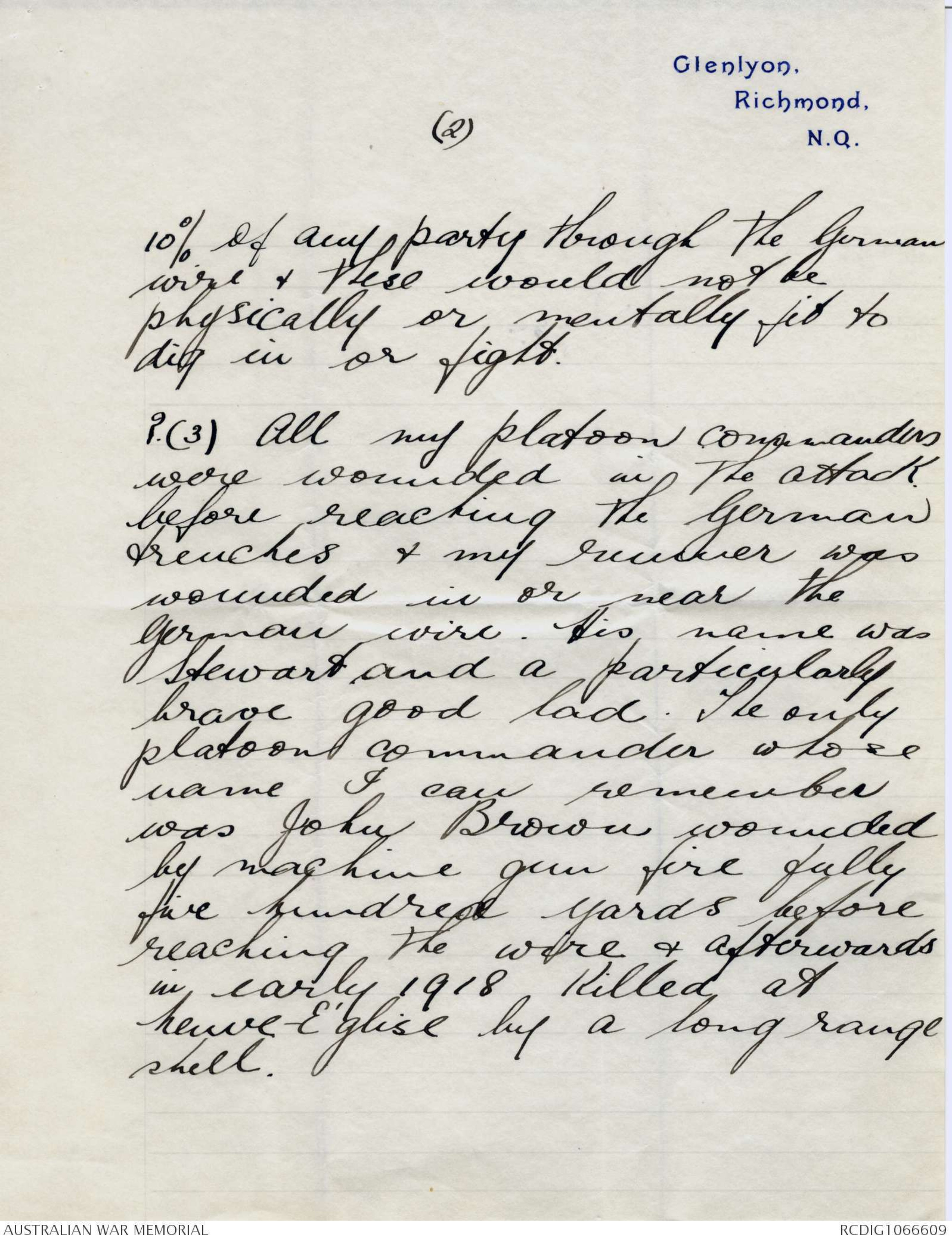
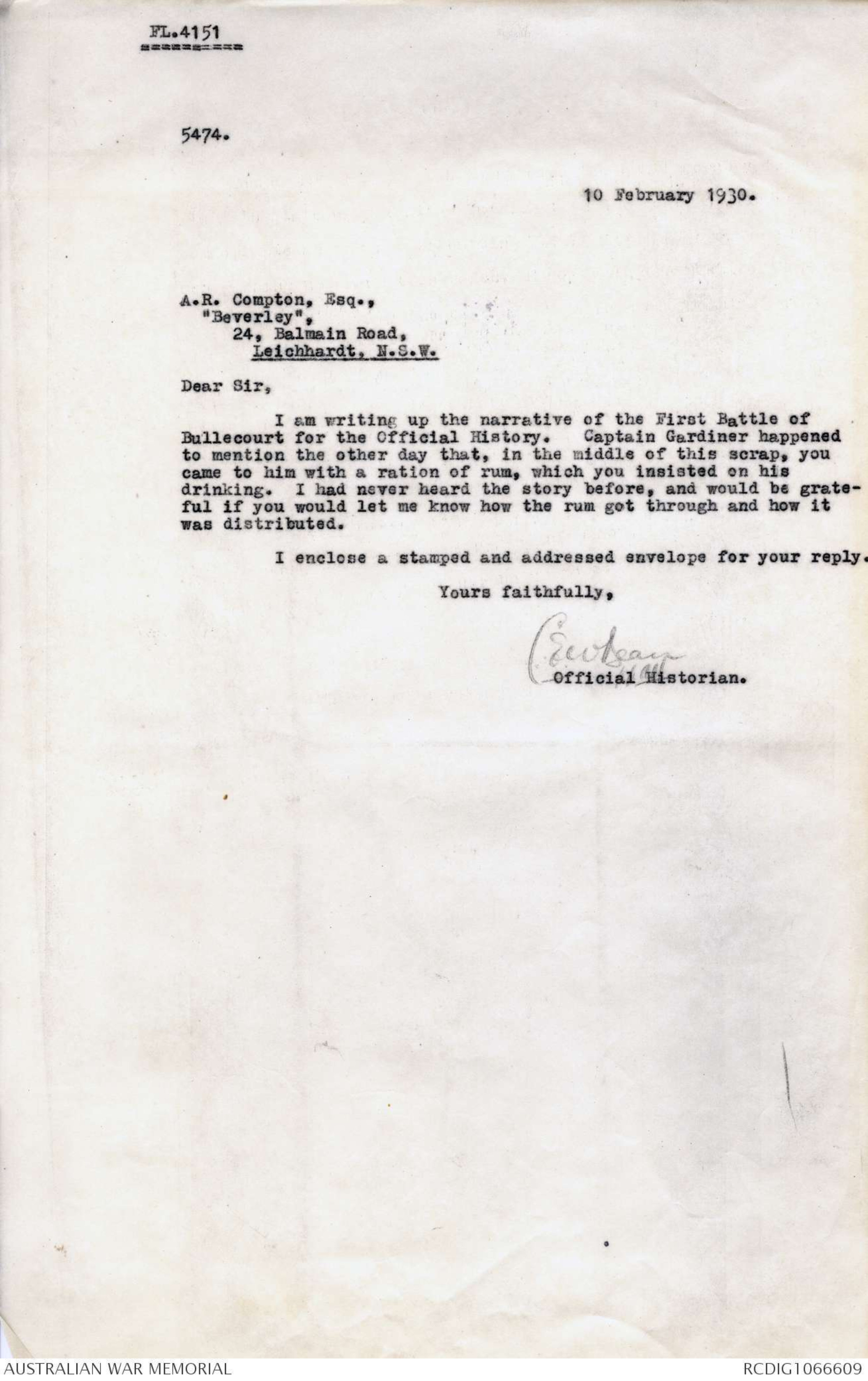
the above. Can you kindly
put me on the track?
Yours very sincerely
T.A. White
TELEPHONE:
CENTRAL 4780.
ADDRESS ALL COMMUNICATIONS
TO " THE SECRETARY"
No........
[*H/N
Bullecourt.*]
COMMONWEALTH OF AUSTRALIA.
DEPARTMENT OF DEFENCE.
MELBOURNE.
[*Copied
6/2/24
AWB*]
March 14th 1923
My dear Bean
The document referred
to was shown me by one of the
14th Bn officer's who returned from
Germany after the armistice, I did
NOT see it at the War Office. It
was the intelligence summary
of the German Division opposing
us. which this fellow (Edmunds.)
had picked up in the dug out.
The Germans missed it in searching
him. It gave the names of
Brand, Dunaul, McSharry, Bockman
and self. and an estimate of our
characteristics, based on reports
given by our prisoners (Australian)
The 4th Bde were given a very blood thirsty
"chit" in common with other Australian
troops and stated that it was the
constant policy of the Bde to kill
all prisoners except a few "Samples"
It then went on to say that the
capture of the undermentioned would
be rewarded by a money gratuity as
follows.
Brand 1500 marks
each C.O. 1000 marks
I hasten to add that the mark had
greater value then than now
I was going to get a copy of the
document but was busily engaged
on the now military employment
Section of Demobn at the time and
so missed the opportunity
It was quite apparent that the
Germans had copies of our Forces
lists. because the record of the
Permanent Officers was quite accurate
Will endeavour to get touch
with Edmunds (I feel certain it was he)
if you like, and ascertain if he has
the document still. Hope you
are keeping very fit.
Yours Sincerely
J H Peck
13th BATTALION A. I. F.
REPORT ON OPERATIONS NEAR BULLECOURT, 11th April, 1917.
Reference Maps, 57c N W and 51b S W, 1/10,000.
(1) The Battalion was bivouaced at FAVREUIL and on the 8th April,
the C.O. made a personal reconnaissance of the ground with
Battalion Staff and Company Commanders.
(2) There was a conference of C.O.'s at Brigade Headquarters,
NOREUIL at 10.30 a.m. on 9-4-17 and at 12 midnight on night
10/11th April, 1917.
(3) On morning of 10th the Battalion was in readiness to attack
but owing to tanks being late this attack was cancelled.
(4) No written Battalion orders were issued but the C.O. had
several conferences with Company Commanders and officers, and
all understood their orders. These verbal orders were based
on 4th Aus. Inf. Brigade Order No. 76 of 10-4-17 issued at
6 p.m., and the continuation order of same date issued at
10.45 p.m.
(5) My plan was to have the battalion entrenched in Railway
cutting from C 5 d 2.8 to C 6 c 1.4. At 4.45 a.m. the
battalion was to move out in Artillery formation and follow
the 16th Battalion, and forming lines when the second objective
was crossed, they were to push on in the following formation
Diagram - see original document
and dig in as follows:-
"A" Coy. U 18 c 6.4. to U 24 b 0.6
"B" Coy. U 24 b 0.6 to U 24 a 9.5
"C" Coy. U 24 a 9.5 to U 24 c 6.8
"D" Coy U 24 c 6.8 to U 24 c 4.0.
Four platoons, one per company, were to assist the tanks in
mopping up REINCOURT.
If the 16th Battalion met with serious opposition
in taking the Hindenburg line, the 13th Battalion was to
assist them, and then carry out their full orders as far as
possible.
Four Vickers Guns of No. 1 Section, 4th A.M.G. Coy.
under Lieut. Veness were attached to the battalion and were
allotted one to each company.
(6) At 3.35 a.m. the Battalion was in the railway cutting
ready to move out, and I had a final conference with the officers.
(2)
(7) At 4.45 a.m. punctually, "A" and "B" Companies moved out,
followed later by "C" and "D" Companys at distances of 200 yds.
As soon as they left the shelter of the cutting losses from
shell fire commenced. When about 600 yards from the 1st
objective the battalion came under heavy machine gun fire, which
became more intense at the first wire and officers and men fell
fast. The 16th Battalion had then taken the 1st objective
but were seen to be in very great difficulties with the 2nd
objective, the wire in front of which was uncut, and it was
only too evident that the 16th Battalion had suffered enormous
losses from machine gun fire in taking the 1st objective. The
Tanks had then not reached the first trench; there was a Tank in
the wire, and a German Machine gun only 10 yards from it, firing
heavily on our men. This gun was put out of action by our
leading Company (A). The 13th Battalion pressed on and with
the 16th, took the 2nd objective, mainly by bombing up the
communication trenches and then bombing to the right and left.
They soon established touch with the 14th Battalion on their
left; and by bombing extended their right flank to U 30 b 0.6
and U 30 a 9.4.
The machine gun fire rendered visual signalling impossible
and the open ground swept by machine gun fire was almost certain
death to runners, so that no messages were coming in to
Battalion Headquarters, but at 7.15 a.m. Captain Murray wrote
an account of the situation, which I received at 9 a.m. and
transmitted to Brigade Headquarters by runner.
About 7.20 a.m. a large amount of enemy movement was seen
around REINCOURT. Captain Murray sent up S.O.S. flares for an
artillery barrage but none was forthcoming.
At about 7.30 a.m. the Germans counter-attacked by bombing
down a communication trench from REINCOURT. This was beaten off
and a combined party of 13th and 16th bombers beat the enemy back
this trench to within 100 yards of REINCOURT putting in a block.
At the same time the enemy counter-attacked our right in the
2nd objective with bombs but were beaten back suffering heavy loss.
At 9 a.m. a battalion of the enemy in close formation
moving from QUEANT to the N. of REINCOURT was dispersed by our
machine gun fire, suffering heavy loss.
From then until 10.45 a.m. our men were re-organizing and
consolidating, during which time two small bombing attacks by the
Germans on our left were beaten off. All the bombs were
collected and dumps made near each bombing block.
Captain Murray went along the whole position and reports
that the 4th Brigade held 900 yards of the Hindenburg line. He
commenced the organization of the whole brigade position. At
10.45 a.m. heavy bomb attacks by the Germans were started from
the right and left of both objectives, also down the
communication trench from REINCOURT and a communication trench
running N and S on the W. of REINCOURT, six attacks in all.
These attacks were very severe and our bombs were
quickly exhausted, and our men pressed back to the centre of our
position from all sides. The Germans had machine guns trained
on the parapet which frustrated every endeavour on the part of
our men to go along the top and attack the bombers with the
bayonet.
Attempts to call up an Artillery barrage by power
buzzer and S.O.S. flares failed, the buzzer being jammed by the
Germans and the flares apparently not being observed.
Except where parties were cut off the men tried to get
back over the open under a fearful machine gun and rifle fire;
the losses being very heavy.
Shortly after noon the position was entirely evacuated.
(3)
(8) At nightfall, the remnants of the Battalion under cover of
the outposts of the 52nd Battalion, withdrew to NOREUIL and thence
to FAVREUIL.
(9) The failure of the Tanks was the primary cause of our failure
to carry out our original plan. They were knocked out by an
anti-tank gun situated on the W. side of REINCOURT, at a range of
about 600 yards. This gun was right in the open shooting
over open sights. No Tank reached the second objective, and
only one (perhaps two) crossed the first objective. Our men
put the anti-tank gun out of action with Machine gun fire from
the second objective, but by this time it was too late to save
the tanks. The fact that xxxx our artillery were slow in
putting a barrage on REINCOURT resulted in the bombing attacks being
pressed with great vigour; also the gap between the 4th and 12th
Brigades gave the Germans a great advantage. We did not have
enough had grenades or rifle grenades, but the role allotted
to the 13th Battalion was an above-ground one, hence we took
more S.A.A. and fewer bombs. Ground flares were lit at 8 a.m,
I cannot understand why the R.F.C. thought we were in REINCOURT.
(10) Our losses are as follows:-
Killed Wounded Missing Total.
Officers 6 6 9 21
Other ranks 19 112 358 489
__________________________________________________________
25 118 367 510.
__________________________________________________________
JMA Durrant
Lieut-Colonel,
C.O., 13th Battalion, A.I.F.
5391.
22 January 1930.
Lieut.-Colonel H.W. Murray, V.C., C.M.G., D.S.O., D.C.M.,
Glenlyon,
Via Richmond. N. Q'Land.
Dear Murray,
I have been writing up the narrative of the First Battle
of Bullecourt. The records are fairly complete, but there are a few
points on which I should be grateful for your help, 1f you could give
it to me:-
(1) I remember your telling me that, on hearing of Black’s
death, you looked for him, but I think you said that you were
not sure whether you saw his body, though you were under the
impression that you did. I should be glad if you could give me
the benefit of your recollection on this point; also whether
this was before, after, or during your survey of the trenches.
(2) Some time before the final order to withdraw there was a
conference of a number of officers which decided, if necessary,
to leave the trench and hold on to a line of shell-holes. Can
you tell me what officers were at this conference, for
example, was Sommerville there? Aarons gave me most of the
names, which, as far as I know, included yourself, Gardiner,
Hummerston, Aarons, and Kerr. Was Sommerville or Fletcher
there?
(3) I have a note that all your platoon commanders and your
runner were wounded. I think this occurred before reaching
the trenches. Could you tell me 1f this was so, and what were
their names?
With kind regards,
Yours sincerely,
P.S. I think I remember your telling
me years ago that some photographs of
the Bullecourt fight were in existence.
Could you put me on to anyone who would
be likely to possess them?
Glenlyon,
Richmond,
N.Q.
12 3 30
Dear Captain Bean
I am enclosing replies
to your questions. Have forgotten quite a
lot, the replies are for your use publicly, this
is strictly private, & not in any way for publication
It was George Gardiner's first fight in France
his company. in fact B.C.& D Coys of the 13th had a
pretty good passage over, as the 16th supported by
A. coy of the 13th had for the time smashed
the German fire. It was absolutely impossible
to form any rear line of defence with the German
wire uncut, their absolute command of the position
& good visibility. & there were no shell holes
I saw only 3 on my return journey from the
German trench
Sorry I don't know of any photographs
of Bullecourt- there's quite a lot one could
say, but it's better left unsaid, you would
have your own ideas of the veracity of the various
officers. Aarons left the trench long before the
general retreat, although long reports had gone
back to the 13th & 16th C.O's.
With kindest regard's
Yours Sincerely
H Murray
Glenlyon,
Richmond,
N.Q.
? (1) Black was killed between
the front & support line of
German trench after capturing
the front line & attacking
the support. I saw his body
within fifteen minutes of
his being hit. He was shot
through the head & as I
was assisting the 16th attack
on the support line I had
not time to even take his
personal effects.
? (2) I cannot remember the
names of the officers at the
trench conference. I never
seriously entertained the idea
of forming a line of shell-holes
or digging in behind the German
wire. First because there were
practically no shellholes, secondly
the Germans commanded
the position, with enfilade
oblique & frontal fire. I
estimated we would get only
Glenlyon,
Richmond,
N.Q.
(2)
10% of any party through the German
wire & these would not be
physically or mentally fit to
dig in or fight.
? (3) All my platoon commanders
were wounded in the attack
before reaching the German
trenches & my runner was
wounded in or near the
German wire. His name was
Stewart and a particularly
brave good lad. The only
platoon commander whose
name I can remember
was John Brown wounded
by machine gun fire fully
five hundred yards before
reaching the wire & afterwards
in early 1918 killed at
Neuve E'glise by a long range
shell.
FL.4151
5474.
10 February 1930.
A.R. Compton, Esq.,
"Beverley",
24, Balmain Road,
Leichhardt. N.S.W.
Dear Sir,
I am writing up the narrative of the First Battle of
Bullecourt for the Official History. Captain Gardiner happened
to mention the other day that, in the middle of this scrap, you
came to him with a ration of rum, which you insisted on his
drinking. I had never heard the story before, and would be grateful
if you would let me know how the rum got through and how it
was distributed.
I enclose a stamped and addressed envelope for your reply.
Yours faithfully,
C E W Bean
Official Historian.
 Deb Parkinson
Deb ParkinsonThis transcription item is now locked to you for editing. To release the lock either Save your changes or Cancel.
This lock will be automatically released after 60 minutes of inactivity.